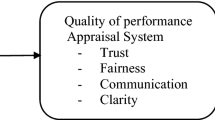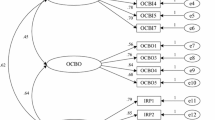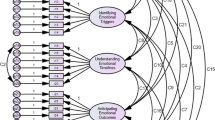Abstract
This study investigated the discriminant validity of cognitive ability, managerial potential, fear of negative evaluation, interaction anxiousness, and audience anxiousness as predictors of managerial performance. As hypothesized cognitive ability significantly predicted only thinking and knowledge criteria. However, managerial potential was significantly correlated with all the criteria. As predicted, fear of negative evaluation predicted thinking and knowledge criteria, interaction anxiousness, and audience anxiousness. In turn, as predicted, interaction anxiousness significantly predicted interpersonal behavior and audience anxiousness significantly predicted communication behavior. Managerial potential and fear of negative evaluation were the only two predictors that were significantly correlated with overall performance.
Similar content being viewed by others
REFERENCES
Alpander, G. C. (1974). Planning management training programs for organizational development. Personnel Journal, 53, 15–21.
Austin, J. T., & Villanova, P. (1992). The criterion problem: 1917–1992. Journal of Applied Psychology, 77, 836–874.
Baehr, M. E., & Orban, J. A. (1989). The role of intellectual abilities and personality characteristics in determining success in higher-level positions. Journal of Vocational Behavior, 35, 270–287.
Bentz, V. J. (1988). Commentary: Comments on papers concerning fairness in employment testing. Journal of Vocational Behavior, 33, 388–397.
Bollen, K. A. (1989). Structural equations with latent variables. New York: Wiley.
Borman, W. C., & Brush, D. H. (1993). More progress toward a taxonomy of managerial performance requirements. Human Performance, 6, 1–21.
Buss, A. H. (1980). Self-consciousness and social anxiety. San Francisco: Freeman.
Camacho, L. M., & Paulus, P. B. (1995). The role of social anxiousness in group brainstorming. Journal of Personality and Social Psychology, 68, 1071–1080.
Campbell, J. P. (1990). Modeling the performance prediction problem in industrial and organizational psychology. In M. D. Dunnette & L. M. Hough (Eds.), Handbook of industrial and organizational psychology (2nd ed., Vol. 1, pp. 687–732). Palo Alto, CA: Consulting Psychologists Press.
Campbell, J. P., Dunnette, M. D., Lawler, E. E., & Weick, K. E. (1970). Managerial behavior, performance, and effectiveness. New York: McGraw-Hill.
Cheek, J. M., & Buss, A. H. (1982). Shyness and sociability. Journal of Personality and Social Psychology, 41, 330–339.
Day, D. V., & Lord, R. G. (1989). Executive leadership and organizational performance: Suggestions for a new theory and methodology. Journal of Management, 14, 453–464.
Duncan, O. D. (1975). Introduction to structural equation models. New York: Academic Press.
Ellis, A. (1962). Reason and emotion in psychotherapy. New York: Lyle Stuart.
Gaugler, B. B., Rosenthal, D., Thornton, G. C., 3rd, & Bentson, C. (1987). Meta-analysis of assessment center validity. Journal of Applied Psychology, 72, 493–511.
Gaugler, B. B., & Thornton, G. C., 3rd (1989). Number of assessment center dimensions as a determinant of assessor accuracy. Journal of Applied Psychology, 74, 611–618.
Goodstein, L. D., & Schrader, W. J. (1963). An empirically-derived managerial key for the California Psychological Inventory. Journal of Applied Psychology, 47, 42–45.
Gough, H. G. (1984). Amanagerial potential scale for the California Psychological Inventory. Journal of Applied Psychology, 69, 233–240.
Guion, R. M. (1991). Personnel assessment, selection, and placement. In M. D. Dunnette & L. M. Hough (Eds.), Handbook of industrial and organizational psychology (2nd ed., Vol. 2, pp. 328–397). Palo Alto, CA: Consulting Psychologists Press.
Harris, M. M., & Schaubroeck, J. (1988). A meta-analysis of self-supervisor, self-peer, and peer-supervisor ratings. Personnel Psychology, 41, 43–62.
Hogan, R. T. (1991). Personality and personality measures. In M. D. Dunnette & L. M. Hough (Eds.), Handbook of industrial and organizational psychology (2nd ed., Vol. 2, pp. 873–919). Palo Alto, CA: Consulting Psychologists Press.
Jacobs, T. O., & Jacques, E. (1987). Leadership in complex systems. In J. Zeidner (Ed.), Human productivity enhancement (pp. 7–65). New York: Praeger.
Joreskog, K. G., & Sorbom, D. (1989). LISREL 7: A guide to the program and applications (2nd ed.). Chicago, IL: Joreskog and Sorbom/SPSS Inc.
Kaplan, R. (1993). 306-degree feedback PLUS: Boosting the power of coworker ratings for executive. Human Resource Management, 32, 299–314.
Kessler, R. C., & Greenberg, D. F. (1981). Linear panel analysis: Models of quantitative change. New York: Academic Press.
Landy, F. J. (1986). Stamp collecting versus science: Validation as hypothesis testing. American Psychologist, 41, 1183–1192.
Landy, F. J., Shankster, L. J., & Kohler, S. S. (1994). Personnel selection and placement. Annual Review of Psychology, 45, 261–296.
Leary, M. R. (1983a). Social Anxiousness: The construct and its measurement. Journal of Personality Assessment, 47, 66–75.
Leary, M. R. (1983b). A brief version of the Fear of Negative Evaluation Scale. Personality and Social Psychology Bulletin, 9, 371–376.
McClelland, D. C. (1993). Intelligence is not the best predictor of job performance. Current Directions in Psychological Science, 2, 5–6.
McHenry, J. J., Hough, L. M., Toquam, J. L., Hanson, M. A., & Ashworth, S. (1990). Project A validity results: The relationship between predictor and criterion domains. Personnel Psychology, 43, 335–354.
Mumford, M. D., Baughman, W. A., Threlfall, K. V., Uhlman, C. E., & Costanza, D. P. (1993). Personality, adaptability, and performance: Performance on well-defined and ill-defined problem-solving tasks. Human Performance, 6, 241–285.
Nilsen, D., & Campbell, D. (1993). Self-observer rating discrepancies: Once an overrater, always an overrater? Human Resource Management, 32, 265–281.
Nunnally, J. C., & Bernstein, I. H. (1994). Psychometric theory (3rd ed.). New York: McGraw-Hill.
Peterson, D. B. (1993). Skill learning and behavior change in an individually tailored management coaching and training program. Unpublished doctoral dissertation, University of Minnesota.
Pilkonis, P. A. (1977). The behavioral consequences of shyness. Journal of Personality, 45, 596–611.
Ree, J. R., Earles, J. A., & Teachout, M. S. (1994). Predicting job performance: Not much more than g. Journal of Applied Psychology, 79, 518–524.
Saari, L. M., Johnson, T. R., McLaughlin, S. D., & Zimmerle, D. M. (1988). A survey of management training and education practices in US companies. Personnel Psychology, 41, 731–743.
Salter, A. (1949). Conditioned reflex therapy. New York: Farrar, Straus.
Schlenker, B. R., & Leary, M. R. (1982). Social anxiety and self-presentation: A conceptualization and model. Psychological Bulletin, 92, 641–669.
Schmidt, F. L. (1988). The problem of group differences in ability test scores in employment selection. Journal of Vocational Behavior, 33, 272–292.
Schneider, R. J., & Hough, L. M. (1995). Personality and Industrial/Organizational Psychology. In C. L. Cooper, & I. T. Robertson (Eds.), International review of industrial and organizational psychology (Vol. 95). Chichester, England: Wiley.
Smith, J. E., Carson, K. P., & Alexander, R. A. (1984). Leadership: It can make a difference. Academy of Management Journal, 27, 765–776.
Simonton, D. K. (1994). Greatness: Who makes history and why. New York: The Guilford Press.
Sternberg, R. J., & Wagner, R. K. (1993). The g-ocentric view of intelligence and job performance is wrong. Current Directions in Psychological Science, 2, 1–5.
Stampfl, T. G., & Levis, D. J. (1976). Implosive therapy: Theory and technique. In J. T. Spence, R. C. Carson, & J.W. Thibaut (Eds.), Behavioral approaches to therapy. Morristown, NJ: General Learning Press.
Thomas, A. B. (1988). Does leadership make a difference to organizational performance? Administrative Science Quarterly, 33, 388–400.
Tornow, W. W.(1993). Perceptions or reality: Is multi-perspective measurement a means or an end? Human Resource Management, 32, 221–229.
Van Velsor, E., Taylor, S., & Leslie, J. (1993). An examination of the relationships between self perception accuracy, self awareness, gender, and leader effectiveness. Human Resource Management, 32, 249–263.
Watson, D., & Friend, R. (1969). Measurement of social-evaluative anxiety. Journal of Consulting and Clinical Psychology, 33, 448–457.
Weiner, N., & Mahoney, T. A. (1981). A model of corporate performance as a function of environmental, organizational, and leadership influences. Academy of Management Journal, 24, 453–470.
Welkowitz, J., Ewen, R. B., & Cohen, J. (1991). Introductory statistics for the behavioral sciences (4th ed.). Fort Worth, TX: Harcourt Brace Jovanovich.
Wesman, A. G. (1965). The Wesman personnel classification test (manual). New York: The Psychological Corporation.
Wolpe, J. (1958). Psychotherapy by reciprocal inhibition. Stanford, CA: Stanford University Press.
Young, B. S. (1996). Social anxiousness constructs as predictors of managerial performance. Doctoral dissertation, Texas A & M University. (University Microfilms No. 9634877)
Zimbardo, P. G. (1977). Shyness: What it is and what to do about it. New York: Jove.
Author information
Authors and Affiliations
Rights and permissions
About this article
Cite this article
Young, B.S., Arthur, W. & Finch, J. Predictors of Managerial Performance: More Than Cognitive Ability. Journal of Business and Psychology 15, 53–72 (2000). https://doi.org/10.1023/A:1007766818397
Issue Date:
DOI: https://doi.org/10.1023/A:1007766818397




